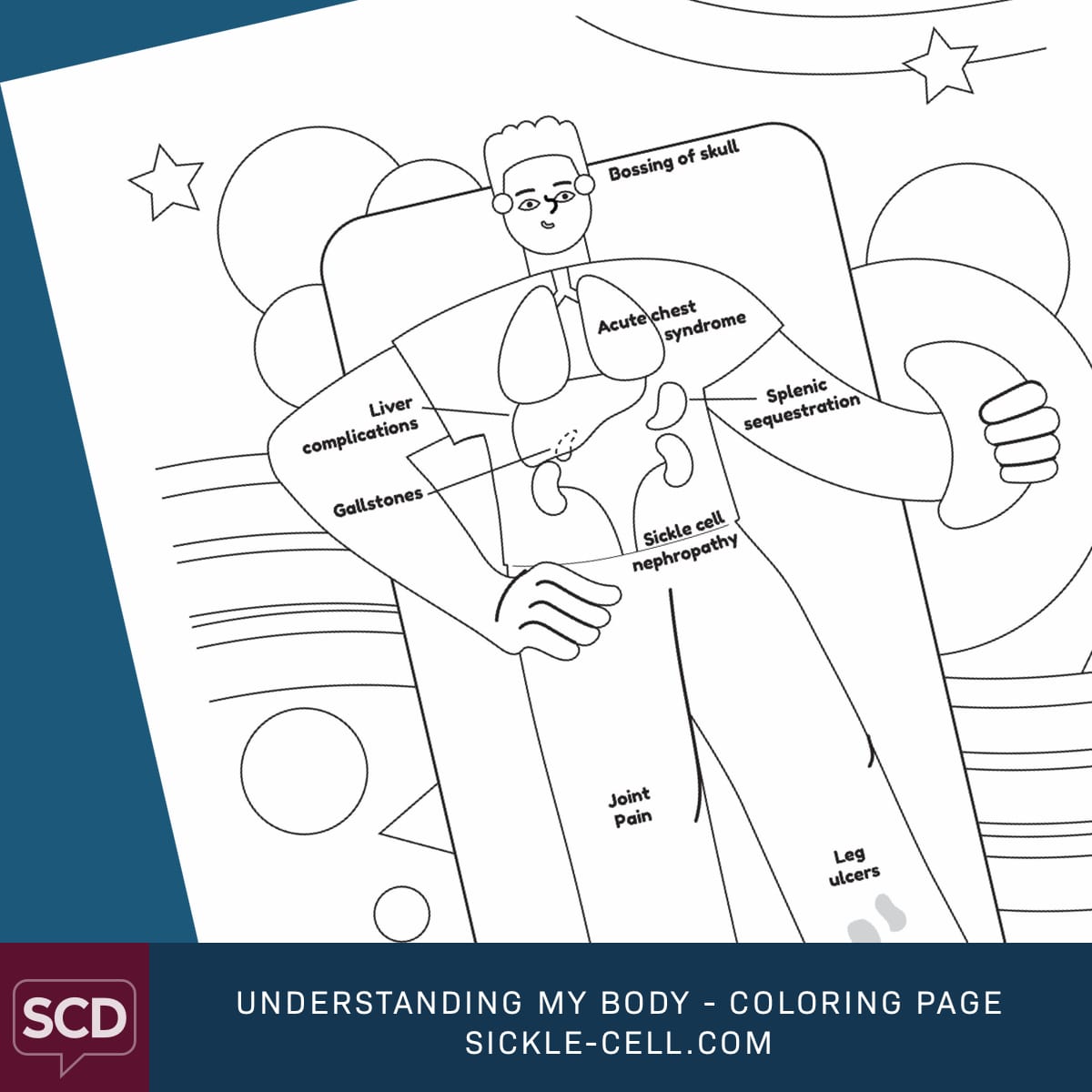Understanding My Body - Coloring Page
Sickle cell disease is caused by an abnormal protein in red blood cells. This can cause different symptoms and complications, including joint pain, leg ulcers, and acute chest syndrome.
Knowing where symptoms or complications are can help you identify problems with sickle cell early. Below, you'll find definitions for several symptoms and complications along with a coloring page that shows where that symptom or complication is located on the body.
What are symptoms and complications?
Symptoms are problems experienced by someone with a disease. Symptoms of sickle cell may include bossing of the skull and fatigue. Complications usually happen when a disease worsens. They can cause someone to experience certain symptoms. Complications of sickle cell may include acute chest syndrome and kidney problems (or sickle cell nephropathy).
Symptoms and complications of sickle cell
Bossing of the skull
Bossing of the skull is a common symptom for children with sickle cell disease. Bossing of the skull or frontal bossing refers to increased bone growth in the skull, often leading to enlarged foreheads.
Acute chest syndrome
Acute chest syndrome is common after a pain crisis. It is characterized by limited blood flow to the lungs and happens when something other than air is in a part of the lungs. Acute chest syndrome can cause infections or asthma. If you're experiencing symptoms of acute chest syndrome, such as chest pain, fever, cough, arm and leg pain, rib and sternal pain, or shortness of breath, go to a hospital immediately.
Gallstones
Gallstones form in the gallbladder, located on the right side of the abdomen, below the liver. Gallstones are rock-like structures that are created when too many sickle cells burst and release their contents into the bloodstream.
Symptoms including abdominal pain, nausea, fever, yellow skin or eyes, dark urine, and clay-colored stool may be experienced with gallstones. You can talk to a healthcare provider about treatment and prevention options.
Liver complications
The liver is located on the right side of your torso. It produces substances that help digest food and eliminate toxins in the body. In people with sickle cell, liver problems may be associated with pain crises. Blood transfusions are a risk factor for liver problems, but they can also be caused when sickle cells block blood vessels. Gallstones can also lead to liver complications.
Splenic sequestration
The spleen is on the left side of the abdomen. Splenic sequestration happens when trapped red blood cells cause the spleen to expand. It can cause severe anemia. Splenic sequestration most commonly affects young children with sickle cell. Symptoms of splenic sequestration include pale skin and lips, weakness, trouble breathing, extreme thirst, fast heartbeat, poor appetite, or swelling and pain in the stomach. Contact a doctor immediately if you or your child is experiencing these symptoms.
Sickle cell nephropathy or chronic kidney disease
Sickle cell nephropathy or chronic kidney disease includes a range of kidney problems. Kidneys are located mid-upper back at the bottom of the rib cage. Symptoms of kidney problems include frequent urination, nighttime bedwetting, high blood pressure, bloody urine, nausea or vomiting, fatigue, weakness, or shortness of breath and chest pain. Prevention and treatment options exist.
Joint pain
Knees, hips, and other joints or bones may experience pain. This pain is caused when sickled red blood cells block blood vessels.
Leg ulcers
Leg ulcers are sores or wounds that normally appear above the ankle. These may last weeks or months and can cause pain. Low circulation is a risk factor for leg ulcers. Hydration and moderate exercise can reduce the risk of this complication.

Join the conversation